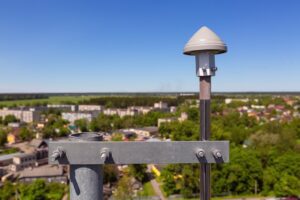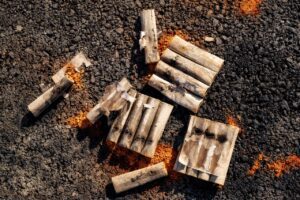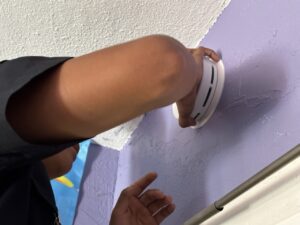When MySafe:LA first began visiting elementary schools in 2008, our objectives were clear and simple: deliver fire and life safety education that would help change people’s behavior. The idea was to bring elements that were not available to the local fire department to schools — essentially to support the fire department with a specific type of expertise. It worked.
Since then, we’ve been continually reviewing and revamping our programs, which range from teaching fire and life safety to 4th and 5th graders to teaching older adults, and even firefighters. As we learn from our students, we work to make our programs stronger and more engaging. If there is no interactivity, entertainment, and engagement, the programs will not be received as they should. Currently, while we focus on fire and earthquake, we also have programs for pedestrian safety, water safety, and heart health (we teach hands-only CPR).
In 2011, we began looking closely at a program called Vision 20/20. It was of interest to us because it wasn’t being delivered by any single organization. It was a project – a program – managed by a former fire marshal and involving fire marshals and fire safety people (like us) from across the country. The stated mission: Community Risk Reduction (CRR).
So, what is Community Risk Reduction? Let’s start with what it is not: fire prevention with a new name. In these early stages, some fire departments are calling their fire prevention units CRR units now. That’s short sighted and misses the core point of what CRR is.
Community Risk Reduction isn’t a thing. It’s a process. It’s also timely, as the fire service is going through some of the most significant changes seen in more than a century.
Today’s first responder world is far more complex than ever before. In Los Angeles, 86% + of the emergency responses by LA firefighters are for medical emergencies — not fires. In addition to that, the variables in emergency responses are vast, ranging from terrorism to natural disasters. That’s a lot to put on any agency’s plate of skills.
So, Community Risk Reduction, or CRR for short, is a process that envisions engaging the public and looking at ways to prevent what might happen in the future – so that in fact that issue never does occur. It’s the raw objective of fire prevention – to prevent fire.
It starts with analysis, includes planning, engages training, then is distributed by firefighters in the community. In our case, we do it all – from script to screen. One other key point: We believe CRR is an “all risk” process – not just about fires or smoke alarms.
Overall, the idea is to look at things that might happen in the future – in specific time ranges (5 years, 10 years, etc.) and to evaluate what might happen if they were to occur. As one example, the USGS estimates that Southern California will suffer a damaging and significant earthquake at some point in the coming 30 years. So, what will likely happen? Who will be affected? And how do we prepare to mitigate the results of a major quake?
Once those areas wherein CRR issues exist, a plan must be developed to help educate, process, and manage efforts to reduce the RISK from that threat. In the case of a major earthquake, that means knowing what not to do – like running – and how to be prepared (having 72 + hours of food, water, medical supplies, etc.). It might also mean a large house should have a generator, or solar panels on the roof. So, as you can see, CRR isn’t a name — it’s a process.
How do we know CRR works? We are asked this question quite often. Although the “name” has evolved over the years, CRR as a process isn’t new. It’s been around a long time. One of the first published accounts of the process came about in 1973, when the report America Burning was released. That report noted two significant issues in fighting fire: First, there wasn’t a sufficient focus on prevention by the fire service. Second, a properly executed prevention program has the potential to make a strong impact on fire.
Another area of significant results related to CRR is Great Britain. Following a 2002 – 2003 strike by firefighters related to improving their working conditions and salaries (that was ultimately successful), a new emphasis was placed on the prevention of fires.
Fire Prevention expert Philip Schaenman produced a highly regarded study report titled, Global Concepts in Residential Fire Safety: Part 1, Best Practices from England, Scotland, Sweden and Norway (2007). Since that time, fire prevention is viewed differently by politicians, firefighters, and the general public. They “get it” and work collectively to prevent fires before they start.
So, what does MySafe:LA do about CRR?
We start by assessing risk in the community. Where are buildings most likely to burn? Who is most likely to die in those fires? Where will earthquake damage be most significant? Where are people most likely to be hit by cars or trains. Those types of questions must come first.
The next step is to create a demographic profile of the areas within the community that are at risk. That may start with a review of census data, but it cannot stop there. There is so much more information required – and in fact that may be more relevant. For MySafe:LA, we look at things like Title 1 schools (schools where students are considered to be in poverty or transient). We talk to the Department of Aging. We look at fire histories. We review data from the National Fire Incident Reporting System (called NFIRS by firefighters). And we look at a lot of other demographic factors as well.
Once we have that data organized, we put the academic issues aside and take a practical look. “What’s happening, guys?” “Where are things going sideways?” And, we look at history. Where did significant earthquakes occur in California. In the world. How might those affect us? Where are buildings burning? At what time of year? At what time of day?
Finally, we combine the academic with the practical – and that establishes how we need to move forward with the process of education, awareness, and risk reduction practices. I’ll address our practices in another entry in the future.
Finally, I should note that we are also asked, “if you’re doing CRR work, does that mean the LAFD shouldn’t do it?” I always smile at this question. The fire service is competitive. The rush to be the best at saving life and property is often considered a race. But it shouldn’t be. In Los Angeles, there are four million people living and working — and commuting. For them to feel safe in their homes, they must have confidence in their fire department. Every fire department, including the LAFD should absolutely create a CRR unit. But, it should be realistic – going to a school here or there or showing up at an event is just “checking the boxes.” A major metro fire department’s CRR unit should be about collaborative research. A small or mid-size agency may be able to do it all, but it’s a matter of resources, budget, and expertise. Thats another reason why we exist – we take no funds from fire departments. Our funding comes in the form of NGO grants and gifts. We’re a force multiplier for the fire service.
The reason MySafe:LA exists is because we can do things no fire department can effectively and efficiently do. The time for “we do it all” is over. We have award-winning filmmakers, teachers, analysts, and medical people on our team. What we don’t do is put out fires. We don’t transport people to hospitals. We don’t enforce the fire code.
We conduct analysis. We build films, animations, graphics, websites, and print materials that win awards. We deliver our programs with EMTs and paramedics (who work for us), as well as experienced educators. We engage with local politicians, the Red Cross, Emergency Operation Centers – and most importantly, the public. We research and count everything. Metrics is what determines need and effectiveness. No metrics = no success.
At MySafe:LA, we believe that a strong CRR program is a collaboration. Just as CRR itself is a process, the successful program will include multiple types of skills and expertise. Any metro fire marshal that thinks otherwise is missing the point. Reducing risk in the community in the 21st century is a rapdily changing, expert-driven, time consuming endeavor. Just as a top rock band employs terrific session musicians and backup singers to make their performances outstanding, so should fire departments collaborate with outside entities, ranging from the American Red Cross to the Office of the State Fire Marshal to agencies like MySafe:LA. In working together, we can make a difference: a safer, more resilient community.







